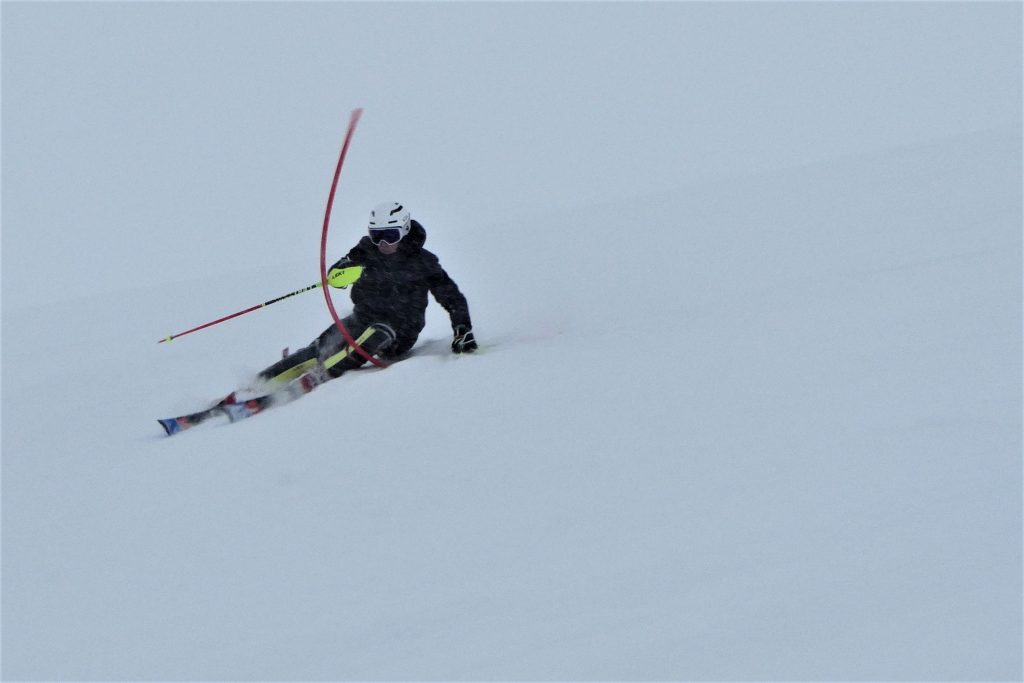The header photograph of Tignes was taken on Wednesday with today being the exact opposite weather conditions – snow, rain, high wind at altitude and high avalanche risk. Major swings in the weather topping off one of the strangest winter seasons ever.
Skating
The role of gravity in bipedal propulsion was explored with skating on the flat. Our main objective was to increase awareness of the Centre of Mass and how we use it – actively falling forward and then rising up again.
The following video clips show how through skating we can turn by incremental displacement of the centre of mass. Ideally this is the first way anyone should learn how to turn and serves as an introduction to dynamics and develops independent leg action.
Due to weather and difficulty getting the session started properly there was no filming of the skiing prior to working on changes.
Even on gentle terrain everyone’s first turns exhibited an absence of conscious use of dynamics with various different compensations being used. Thomas was pushing both his ski tails out to the side, Molly was stemming her uphill ski into a plough. Harry was trying to edge but in doing so was not getting his centre of mass into the turn. Nick was unstable and in a Star Wars epic battle with the Dark Force and Helen was stemming also – everyone very upright.
Here’s a photograph of one of my trainees really using dynamics …

Dynamics
Dynamics is the physics of disequilibrium (accelerations) – described accurately by Newton’s second law: Force= Mass X Acceleration (F=mA). Acceleration means change of speed or direction or both. Skiing is about continuous organised accelerations and the ski is designed to organise the accelerations in a very similar way to a bicycle.
To put “dynamics” simply – your job is to fall over (to one side or other of the ski’s direction of travel) and the ski’s job is to lift you back up.
The idea that we use balance in skiing or that forces are balanced is completely incorrect and is derived from abstract mathematics that does not describe nature. Ski instruction derived from such misinterpretations is accordingly incorrect also.
All that really counts in skiing is the motion of the centre of mass – the skis will support this motion irrespective of which ski is used or which edge is used. More can be read about dynamics at the following link: “Dynamics“.
Modified Snowplough
The ski resort had a sign up saying that the run with an unpronounceable name was closed – but nobody translated this into meaning the blue run we began the descent on would morph into a red one in horrible condition – with minor avalanches landing on top of us. Not ideal for a first run after missing two years – especially for Molly age 11.
However – this was an opportunity to work on strategy for getting down un-ski-able terrain and for developmental exercises. The additional problem was that the snow was both horribly sticky and soapy – a very weird and uncommon combination.
First of all we used side slipping and tried to control it with the centre of mass – moving it downhill to trigger a slip and back uphill to stop – very difficult with the weird snow. Eventually we moved on to simply side stepping down the hill where Molly’s tendency to turn and face uphill for security was corrected so that she would face more downhill and turn her bottom only to face uphill so as to “angulate” and put the skis on a more pronounced edge for better grip.
Eventually we gave this up and just walked down – or rather Molly got her smile back by sliding down on her bottom. The only danger that had been present was other skiers who were both out of control and totally impatient. Molly handled it all very well.
Back on safe ground Molly was taught the Modified Snowplough or “Braking Plough”. This is where the weight goes onto the inside ski for the first half of the turn and uses it as a brake feeding the skier progressively into the turn until the other ski comes below and then it can be used as a brake. This turn also depends on the correct movement of the centre of mass and exposes very clearly the fallacy of “weight transfer” in the snowplough that Molly had been taught in ski schools – and was the cause of her difficulties. We used this exercise as an introduction to pivoting.
Pivot
The pivot is where “pole plant” finally makes sense! The pole is used to support the centre of mass in a controlled manner. Details of the pivot are found at this link: “Pivot“
Each skier was assisted through a pivot so that the sensation could be experienced. Ideally we would have been skiing using dynamics instead but this direction (pivot) was taken early due to the need to prioritise Molly’s safety and allow her to get experience with the braking plough while others could work on pivoting.

